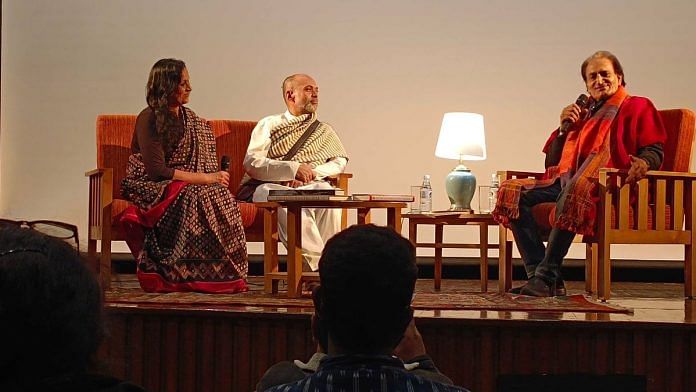New Delhi: When veteran photographer Raghu Rai is speaking, things are likely to become as candid as possible, just like thousands of his pictures. On his daughter filming him for a documentary about his life, Rai bluntly said he wasn’t “fond of the idea that your own child makes a film on you or writes a book on you”.
In 2017, his daughter Avani Rai released the documentary Raghu Rai: An Unframed Portrait, of which filmmaker Anurag Kashyap was an executive producer.
“…also, being photographed is boring for me,” said Rai, looking at his daughter, who was sitting among the audience at the CD Deshmukh Auditorium in Delhi’s India International Centre.
Rai conversed with author-curator Sujata Prasad and theatre artiste Oroon Das before a packed house. And the trio knew very well the art of keeping the audience glued for more than 90 minutes – primarily through Rai’s storytelling, interspersed with bouts of humour. Half the house was full much before the scheduled time, when Das was personally checking seating and lighting arrangements in the hall.
The discussion, titled ‘The Decisive Moment’ and organised in collaboration with Ahad Anhad, revisited Rai’s journey as a photographer.
Journalism is the first draft of history and photojournalism is the evidence of history, said Rai. Everyone with smartphones and cameras has become a photographer today, and the Padmashree winner said he found these pictures emotionless, colourless and visual-less.
Recalling Indira Gandhi
At the event, Rai, it seems, knew his assignment of keeping the audience captivated. Apart from his personal journey as a photographer, he recalled his meetings with former Prime Minister Indira Gandhi, as well as the stories behind his iconic photographs — from Mother Teresa at a church to Satyajit Ray on the sets of his 1984 film Ghare-Baire.
Refuting Sujata Prasad’s question on whether Indira Gandhi used to adore him, Rai said: “Indira Gandhi was the prime minister who always appreciated and loved art, culture and heritage and she always respected photographers, writers and artists”.
“The way Modi is everywhere now, back then Indira Gandhi was on every cover page,” he added.
Rai has produced more than 18 books focusing on the heritage, culture and people of India. These include Raghu Rai’s Delhi, The Sikhs, Calcutta/Kolkata, Khajuraho, Taj Mahal, Tibet in Exile, India, and Mother Teresa. He has also served thrice on the jury of the World Press Photo, and twice on the jury of UNESCO’s International Photo Contest.
“I [have] always tried to capture something which can tell the [photograph’s] behind story.”
‘What’s next?’
Stories about Raghu Rai’s life transported the audience back in time. The conversation delved into his childhood, his photojournalism job at Magnum Photos, his journey as a freelance photographer as well as his experiments with photographic tools.
For instance, Rai recalled how he made the switch to digital cameras. It was during an assignment in Mumbai in 2003, post which he was “simply unable” to revert to film. Despite his fondness for digital technology and its time-saving advantages, Rai never clicks any photos with a smartphone.
He came into photography more than 60 years ago, completely “by chance”. When an audience member asked him “what next”, Rai gave a philosophical answer. “Nobody knows what else he [god] demands from you and when. The sense of exploration and connectivity keeps you connected, young and alive.”
Arguably the most acclaimed photographer in India, Rai said he hadn’t lost touch with contemporary developments as he mentioned the farmers’ ‘Delhi Chalo’ march.
Prasad and Das continued to prompt Rai to revisit every aspect of his memory, making him recall the Bhopal gas tragedy, the narrow alleys of Chandni Chowk, the India-Pakistan War and even his naked self-portrait.
Differentiating history from photography, Rai emphasised that while the former can be written and rewritten, photographs can’t be taken again. Then, to an audience member who asked if there was going to be another Raghu Rai, he said: “No, because Raghu Rai is Raghu Rai and he’s doing whatever he needs to do, there will be someone else with their own divine connection and madness to explore the world.”
(Edited by Zoya Bhatti)



